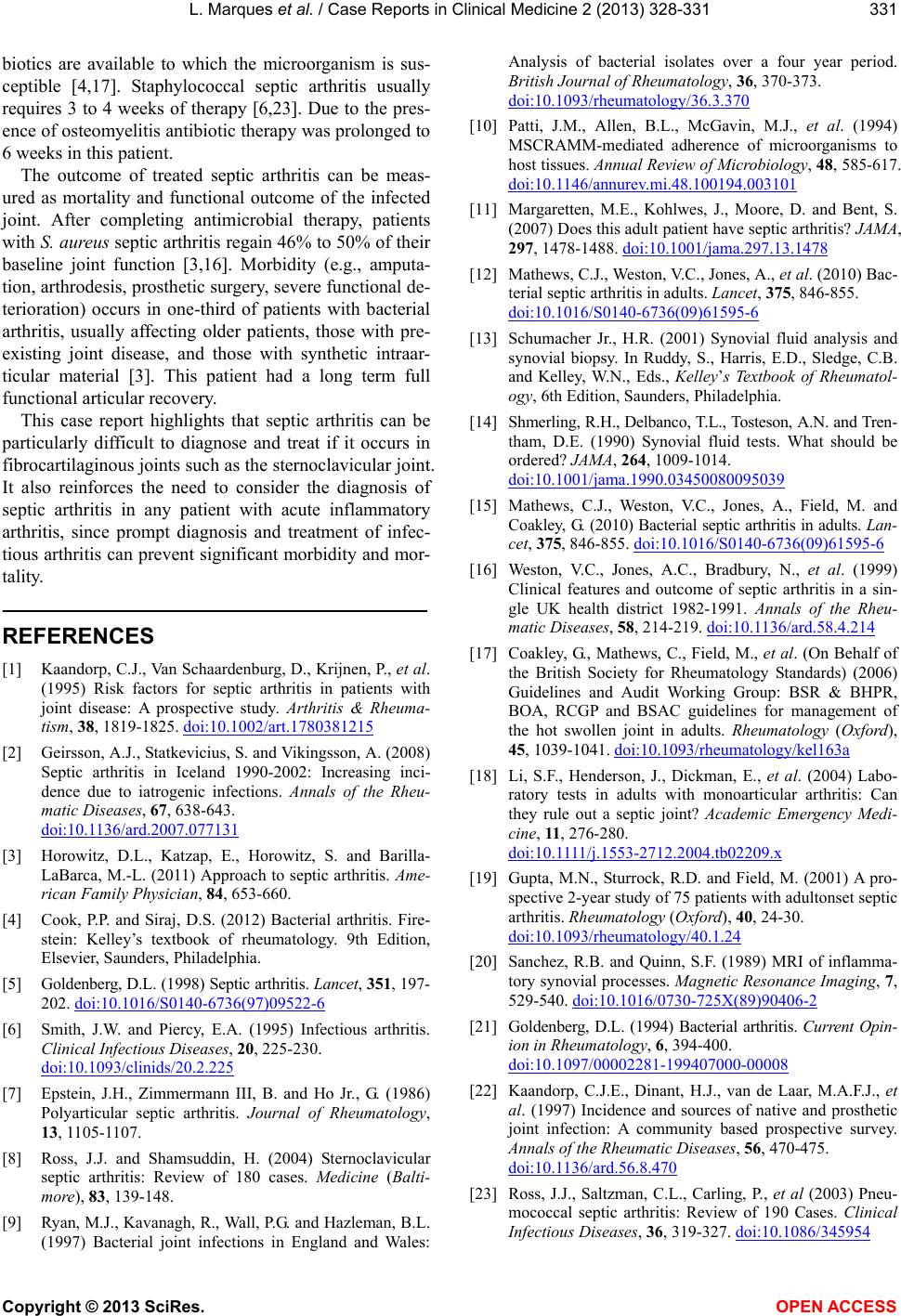
L. Marques et al. / Case Reports in Clinical Medicine 2 (2013) 328-331
Copyright © 2013 SciRes.
331
biotics are available to which the microorganism is sus-
ceptible [4,17]. Staphylococcal septic arthritis usually
requires 3 to 4 weeks of therapy [6,23]. Due to the pres-
ence of osteomyelitis antibio tic therapy was prolonged to
6 weeks in this patient.
OPEN A CCESS
The outcome of treated septic arthritis can be meas-
ured as mortality and functional outcome of the infected
joint. After completing antimicrobial therapy, patients
with S. aureus septic arthritis regain 46% to 50% o f their
baseline joint function [3,16]. Morbidity (e.g., amputa-
tion, arthrodesis, prosthetic surgery, severe functional de-
terioration) occurs in one-third of patients with bacterial
arthritis, usually affecting older patients, those with pre-
existing joint disease, and those with synthetic intraar-
ticular material [3]. This patient had a long term full
functional articular recovery.
This case report highlights that septic arthritis can be
particularly difficult to diagnose and treat if it occurs in
fibrocartilaginou s joints such as the sterno clavicular join t.
It also reinforces the need to consider the diagnosis of
septic arthritis in any patient with acute inflammatory
arthritis, since prompt diagnosis and treatment of infec-
tious arthritis can prevent significant morbidity and mor-
tality.
REFERENCES
[1] Kaandorp, C.J., Van Schaardenburg, D., Krijnen, P., et al.
(1995) Risk factors for septic arthritis in patients with
joint disease: A prospective study. Arthritis & Rheuma-
tism, 38, 1819-1825. doi:10.1002/art.1780381215
[2] Geirsson, A.J., Statkevicius, S. and Vikingsson, A. (2008)
Septic arthritis in Iceland 1990-2002: Increasing inci-
dence due to iatrogenic infections. Annals of the Rheu-
matic Diseases, 67, 638-643.
doi:10.1136/ard.2007.077131
[3] Horowitz, D.L., Katzap, E., Horowitz, S. and Barilla-
LaBarca, M.-L. (2011) Approach to septic arthritis. Ame-
rican Family Physician, 84, 653-660.
[4] Cook, P.P. and Siraj, D.S. (2012) Bacterial arthritis. Fire-
stein: Kelley’s textbook of rheumatology. 9th Edition,
Elsevier, Saunders, Philadelphia.
[5] Goldenberg, D.L. (1998) Septic arthritis. Lancet, 351, 197-
202. doi:10.1016/S0140-6736(97)09522-6
[6] Smith, J.W. and Piercy, E.A. (1995) Infectious arthritis.
Clinical Infectious Diseases, 20, 225-230.
doi:10.1093/clinids/20.2.225
[7] Epstein, J.H., Zimmermann III, B. and Ho Jr., G. (1986)
Polyarticular septic arthritis. Journal of Rheumatology,
13, 1105-1107.
[8] Ross, J.J. and Shamsuddin, H. (2004) Sternoclavicular
septic arthritis: Review of 180 cases. Medicine (Balti-
more), 83, 139-148.
[9] Ry an, M.J., Kavanagh, R., Wall, P.G. and Hazleman, B.L.
(1997) Bacterial joint infections in England and Wales:
Analysis of bacterial isolates over a four year period.
British Journal of Rheumatology, 36, 370-373.
doi:10.1093/rheumatology/36.3.370
[10] Patti, J.M., Allen, B.L., McGavin, M.J., et al. (1994)
MSCRAMM-mediated adherence of microorganisms to
host tissues. Annual Review of Microbiology, 48, 585-617.
doi:10.1146/annurev.mi.48.100194.003101
[11] Margaretten, M.E., Kohlwes, J., Moore, D. and Bent, S.
(2007) Does this adult patient have septic arthritis? JAMA,
297, 1478-1488. doi:10.1001/jama.297.13.1478
[12] Mathews, C.J., Weston, V.C., Jones, A., et al. (2010) Bac-
terial septic arthritis in adults. Lancet, 375, 846-855.
doi:10.1016/S0140-6736(09)61595-6
[13] Schumacher Jr., H.R. (2001) Synovial fluid analysis and
synovial biopsy. In Ruddy, S., Harris, E.D., Sledge, C.B.
and Kelley, W.N., Eds., Kelley’s Textbook of Rheumatol-
ogy, 6th Edition, Saunders, Philadelphia.
[14] Shmerling, R.H., Delbanco, T.L., Tosteson, A.N. and Tren-
tham, D.E. (1990) Synovial fluid tests. What should be
ordered? JAMA, 264, 1009-1014.
doi:10.1001/jama.1990.03450080095039
[15] Mathews, C.J., Weston, V.C., Jones, A., Field, M. and
Coakley, G. (2010) Bacterial septic arthritis in adults. Lan-
cet, 375, 846-855. doi:10.1016/S0140-6736(09)61595-6
[16] Weston, V.C., Jones, A.C., Bradbury, N., et al. (1999)
Clinical features and outcome of septic arthritis in a sin-
gle UK health district 1982-1991. Annals of the Rheu-
matic Diseases, 58, 214-219. doi:10.1136/ard.58.4.214
[17] Coakley, G., Mathews, C., Field, M., et al. (On Behalf of
the British Society for Rheumatology Standards) (2006)
Guidelines and Audit Working Group: BSR & BHPR,
BOA, RCGP and BSAC guidelines for management of
the hot swollen joint in adults. Rheumatology (Oxford),
45, 1039-1041. doi:10.1093/rheumatology/kel163a
[18] Li, S.F., Henderson, J., Dickman, E., et al. (2004) Labo-
ratory tests in adults with monoarticular arthritis: Can
they rule out a septic joint? Academic Emergency Medi-
cine, 11 , 276-280.
doi:10.1111/j.1553-2712.2004.tb02209.x
[19] Gupta, M.N., Sturrock, R.D. and Field, M. (2001) A pro-
spective 2-year study of 75 patients with adultonset septic
arthritis. Rheumatology (Oxford), 40, 24-30.
doi:10.1093/rheumatology/40.1.24
[20] Sanchez, R.B. and Quinn, S.F. (1989) MRI of inflamma-
tory synovial processes. Magnetic Resonance Imaging, 7,
529-540. doi:10.1016/0730-725X(89)90406-2
[21] Goldenberg, D.L. (1994) Bacterial arthritis. Current Opin-
ion in Rheumatology, 6, 394-400.
doi:10.1097/00002281-199407000-00008
[22] Kaandorp, C.J.E., Dinant, H.J., van de Laar, M.A.F.J., et
al. (1997) Incidence and sources of native and prosthetic
joint infection: A community based prospective survey.
Annals of the Rheumatic Diseases, 56, 470-475.
doi:10.1136/ard.56.8.470
[23] Ross, J.J., Saltzman, C.L., Carling, P., et al (2003) Pneu-
mococcal septic arthritis: Review of 190 Cases. Clinical
Infectious Diseases, 36, 319-327. doi:10.1086/345954